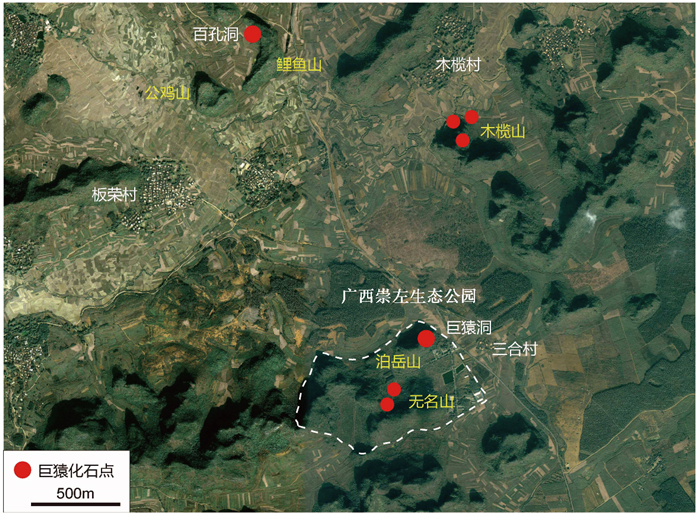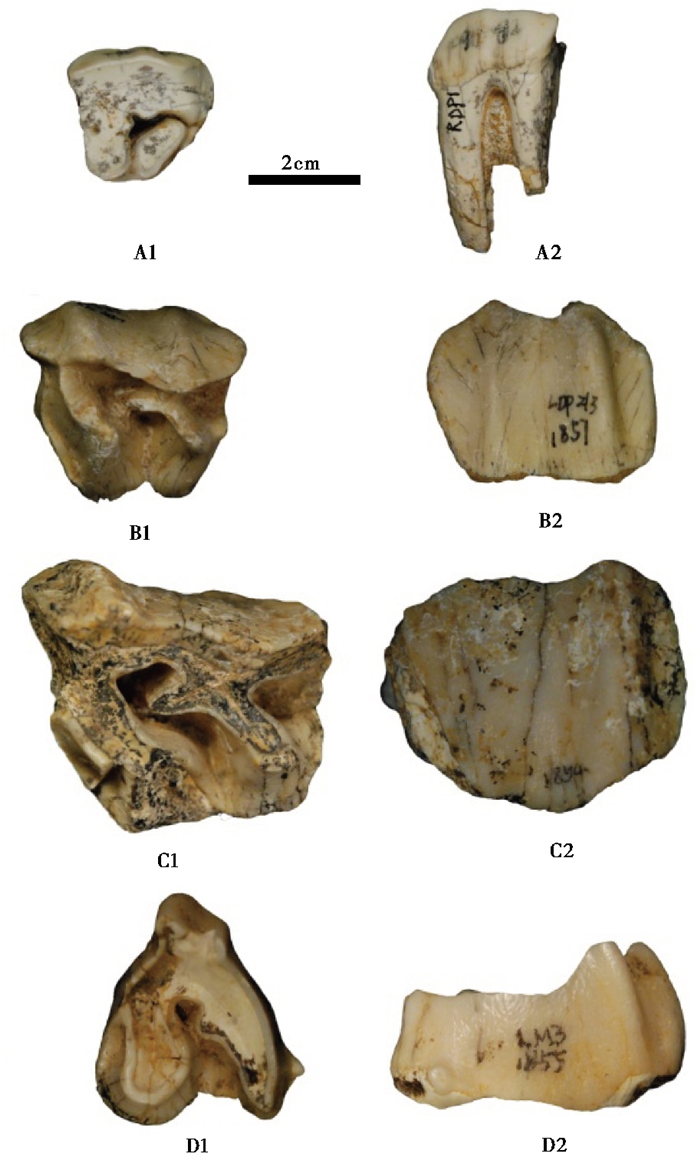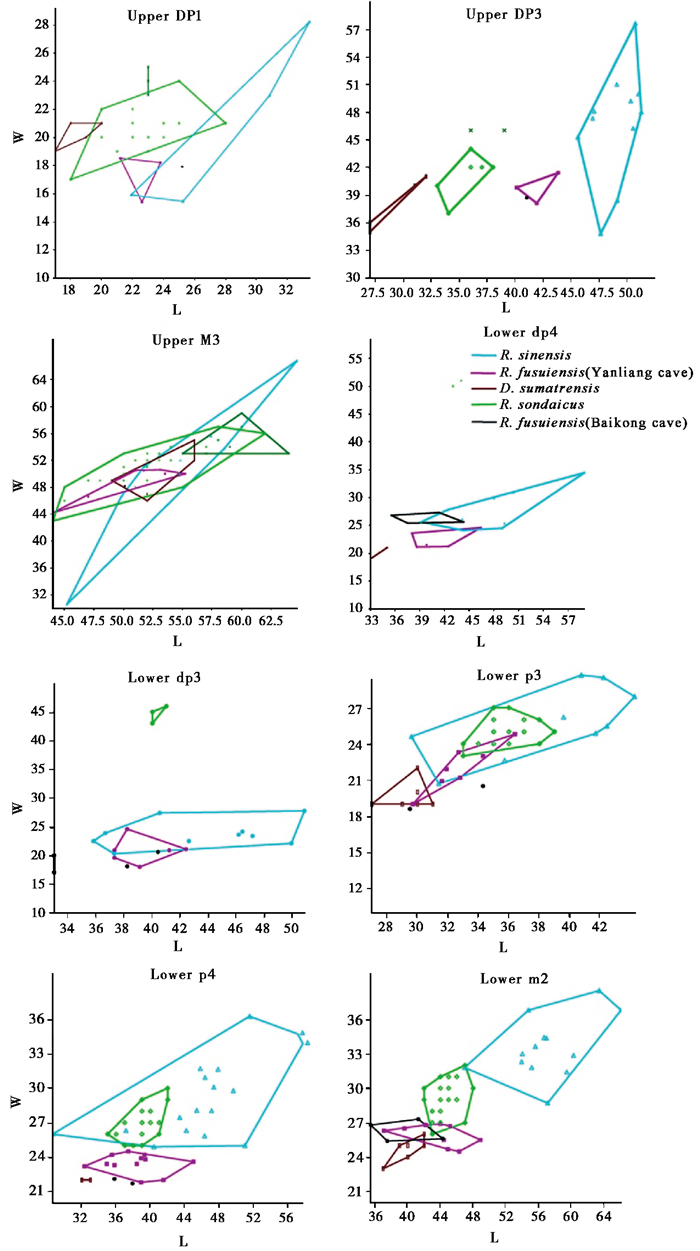② 中国科学院脊椎动物演化与人类起源重点实验室, 中国科学院古脊椎动物 与古人类研究所, 北京 100044;
③ 中国科学院南京地质古生物研究所, 现代古生物学和地层学 国家重点实验室, 南京 210008;
④ 北京师范大学历史学院, 北京 100875)
广西壮族自治区左江流域喀斯特溶洞十分发育,洞穴堆积中蕴藏着丰富的古生物和古人类化石资源。近十余年来,中国科学院古脊椎动物与古人类研究所与北京大学广西崇左生物多样性研究基地等单位合作,对崇左地区晚新生代的洞穴堆积开展了系统的地质古生物调查,发现并系统发掘了多处重要的巨猿化石新地点和古人类遗址,如:鲤鱼山百孔洞、高眼山岩亮洞、泊岳山巨猿洞、无名山三合大洞和缺缺洞、木榄山合江洞以及木榄山智人洞遗址等[1~7],它们分别产自于更新世不同地质时期的洞穴堆积,构成了该区较为连续的第四纪洞穴古生物地层序列。上述新发现确立了广西崇左地区在巨猿演化和早期现代人起源研究上的独特地位。
作为现生和化石灵长类中体型最大的一种,步氏巨猿化石主要发现于我国南方更新世的洞穴、裂隙堆积中,而“巨猿动物群(Gigantopithecus fauna)”[1, 8](或称“巨猿-中华乳齿象动物群(Gigantopithecus-Sinomastodon fauna)”[9])也是我国南方第四纪最受关注的哺乳动物群之一。独角犀(Rhinoceros)是巨猿-中华乳齿象动物群中最典型的大型哺乳动物之一,长期以来受化石标本的制约,我国南方更新世的独角犀化石基本都归入中国犀(Rhinoceros sinensis)一种,未能体现出独角犀在我国南方第四纪生物地层学研究中的重要意义。近年来,Yan等[10, 11]系统研究了产自广西扶绥早更新世早期岩亮洞中丰富的独角犀标本,依据个体小、上臼齿外脊外壁弯曲、M3次尖外侧常见小的釉质突起以及跟骨载距突膨大程度较小等基本形态特征,建立了一新种——扶绥犀(Rhinoceros fusuiensis sp. nov.),并认为扶绥犀在形态上比中国犀更加原始,代表了我国南方第四纪时代最早、形态特征最原始的独角犀类型。
本文将系统研究广西崇左另外两处早更新世的巨猿化石点,即鲤鱼山百孔洞和泊岳山巨猿洞中的独角犀新材料共38件,通过形态观察和比较,确定其分类位置,讨论崇左地区及我国南方早更新世独角犀的地理分布、种群变化、演化特征和生存环境等科学问题。
本文描述中使用的牙齿术语及测量方法,参考了邱占祥和王伴月[12]、Guérin[13]和Fukuchi[14]的建议。DP、P和M代表上颌牙齿,dp、p和m代表下颌牙齿。IVPP V代表中国科学院古脊椎动物与古人类研究所的标本编号。
2 化石产地的地质地理概况本文所研究的独角犀化石分别产自广西崇左鲤鱼山百孔洞和泊岳山巨猿洞(图 1)。

|
图 1 广西崇左生态公园周边的鲤鱼山百孔洞、泊岳山巨猿洞以及其他巨猿化石点 Fig. 1 Geographical distribution of Baikong cave of Liyu Mountain, Juyuan cave of Boyue Mountain and other Gigantopithecus cave sites in the vicinity of the Chongzuo Ecological Park, Guangxi |
鲤鱼山百孔洞(22°17′45.3″N,107°29′54.42″E)位于崇左生态公园以北约3km的板荣村附近的鲤鱼山西坡上,该洞穴是大型管道状溶洞,洞口朝南,洞口底板的海拔高度为216m,是崇左地区迄今含有巨猿化石的所有洞穴中海拔最高的。鲤鱼山百孔洞动物群中含有步氏巨猿(Gigantopithecus blacki)、小种大熊猫(Ailuropoda microta)、桑氏硕鬣狗(Pachycrocuta licenti)、中华黄昏兽(Hesperotherium sinense)、山原貘(Tapirus sanyuanensis)和江南中华乳齿象(Sinomastodon jiangnanensis)等较多新近纪残余种属或第四纪初次出现的种类,其地质时代应为早更新世早期[1]。古地磁结果表明,鲤鱼山百孔洞含巨猿化石的堆积物以负向极性时为主,它应早于早更新世的奥杜威(Olduvai)正向极性时,其相应的年龄值应大于距今200万年[15],但下限的确定仍有待于进一步深入研究。
泊岳山巨猿洞座落于崇左生态公园大门西南20m的国道旁,地理坐标为22°17′21.9″N,107°30′40.1″E,该洞穴是窄长的裂隙状溶洞,洞口大致朝东,洞口底板的海拔高度为206m,是崇左地区第一个发现巨猿化石的洞穴。泊岳山巨猿洞动物群以步氏巨猿(Gigantopithecus blacki)、武陵山大熊猫(Ailuropoda wulingshanensis)、桑氏硕鬣狗(Pachycrocuta licenti)、中国貘(Tapirus sinensis)和扬子中华乳齿象(Sinomastodon yangziensis)等组合为特征,动物群性质与广西步兵盆地的么会洞[16]最为接近,其地质时代应为早更新世早期[1, 2]。依磁性地层年代测定的分析,泊岳山巨猿洞含化石的堆积物以正向极性时为主,相当于奥杜威(Olduvai)正向极性时,相应年龄值为距今约180万年[15]。
3 哺乳动物化石系统描述哺乳纲 Mammalia Linnaeus,1758
奇蹄目 Perissodactyla Owen,1848
犀科 Rhinocerotidae Gray,1820
独角犀属 Rhinoceros Linnaeus,1758
扶绥犀 R. fusuiensis Yan,Wang,Jin et Mead,2014
正型标本:一件完整的上第三臼齿(M3)(V18642.47)
新材料:1件DP1(V22698.01),2件DP2缺失外脊和后脊(V22698.03和V22679.01),2件DP3(V22698.02和V22679.02),3件破损的P3/P4(V22698.05、06和V22679.03),2件M1(V22698.04和07),1件M2(V22698.08),1件M3(V22698.09),3件dp2(V22698.10~12),2件dp3(V22698.13和14),3件dp4(V22698.15~17),1件p2(V22679. 04),5件p3(V22698.18~21和V22679. 05),3件p4(V22698.22~24),3件m1(V22698.25~27),5件m2(V22698.28~32),1件m3(V22698.33)。其中,V22698为鲤鱼山百孔洞的标本33件,V22679为泊岳山巨猿洞的标本5件。
| 表 1 广西崇左扶绥犀新材料的上颊齿测量(mm) Table 1 Measurements of upper cheek teeth of Rhinoceros fusuiensis from Chongzuo, Guangxi(mm) |
| 表 2 广西崇左扶绥犀新材料的下颊齿测量(mm) Table 2 Measurements of lower cheek teeth of Rhinoceros fusuiensis from Chongzuo, Guangxi(mm) |
描述:DP1(V22698.01,图 2A)冠面视近三角形;外脊发育,呈舒缓的弧形;原脊萎缩,强烈倾斜,分别与外脊、后脊相连,中谷开口处封闭;后脊中等发育;后齿带发育,形成小的后窝;有弱的小刺。

|
图 2 广西崇左鲤鱼山百孔洞中的扶绥犀化石 (A)左DP1(V22698.01),(B)左DP3(V22698.02),(C)左M2(V22698.08),(D)左M3(V22698.09) A1~D1,冠面视,A2~D2,颊侧视 Fig. 2 Fossil teeth of Rhinoceros fusuiensis from Baikong cave of Liyu Mountain, Chongzuo, Guangxi. (A)left DP1(V22698.01), (B)left DP3(V22698.02), (C)left M2(V22698.08), (D)left M3(V22698.09); A1~D1, occlusal view, A2~D2, buccal view |
DP2,V22698.03保留了前刺、小刺和原脊的碎块,前齿带发育;V22679.01虽然外脊前部破损,但仍可观察到明显的中附尖肋。
DP3 (V22698.02,图 2B),牙齿轮廓近正方形;前尖肋发育并延伸至牙齿基部;前附尖比前尖弱,前尖肋明显且延伸至齿冠基部;后尖肋微弱;在前尖肋之后,外脊外侧向舌侧凹陷,而后半部分向颊侧翘起;前刺中等发育。中谷开阔,入口处无齿突;原脊内半部膨大,原尖较次尖发育,次尖前收缩和原尖后收缩微弱;后齿带发育,有Ⅴ形缺口,形成较大的后窝。
P3/P4,前尖肋发育,前齿带发育;后齿带发育,且绕至中谷入口处,形成后窝;原脊和后脊在后内部膨大,致使次尖小于原尖;中谷入口处有齿突。
M1/M2(V22698.08,图 2C),牙齿冠面轮廓近四边形;前宽大于后宽,长稍小于宽;前刺发育,无小刺和反前刺;前尖肋明显,但在距离齿冠基部约1cm处减弱,无后尖肋;前附尖微弱,前齿带和后齿带发育并绕至中谷入口处;后齿带无连续Ⅴ形缺口,后窝形成,中谷开阔;原脊和后脊内半部膨大,次尖的宽度大约为原尖的2/3;外脊向舌侧强烈倾斜,后脊稍有萎缩,无原尖收缩和次尖收缩。
M3 (V22698.09,图 2D),牙齿冠面轮廓为三角形;后脊萎缩,与外脊融合为外后脊;前附尖微弱,前尖肋发育;前刺中度发育,前齿带发育,无后齿带,但次尖外侧有小齿突;中谷开阔,入口处平坦,无齿突。
dp2~dp4,dp2的下前尖向前延伸,形成弱的下前附尖;前谷形成,前谷入口较窄,后谷开阔,前谷和后谷入口处均无齿突。dp3稍大于dp2,前叶和后叶近乎相等。dp4与dp3大小接近,牙齿形态与下臼齿接近,但乳齿釉质层薄于臼齿。
p2,下前脊和下原脊没有分开,无下三角座凹;下次脊和下内脊磨蚀后形成封闭的浅窝。
p3/p4,p3整体轮廓为长方形,下前脊没有完全发育,下三角座窄于下跟座,下三角座凹浅于下跟座凹,前叶窄于后叶,后谷比前谷开阔;p4稍大于p3,三角座和下跟座宽度接近,前谷较p3开阔。
m1~m3,形态与p4相似,但前谷更为开阔,颊侧沟更深;m3无后接触面。从m1~m3,三角座和牙齿的长度逐步增加。
比较与讨论:鲤鱼山百孔洞的犀牛上颊齿中出现后脊萎缩等特征此前只发现于化石扶绥犀(Rhinoceros fusuiensis)和现生苏门答腊犀(Dicerorhinus sumatrensis)中[10, 17],而上颊齿的一些特征如:M3次尖外侧有小齿突,DP2上有小刺,DP3上次尖前收缩和原尖后收缩微弱等更接近扶绥犀,牙齿大小(除了DP1) 也基本落在了扶绥犀的范围内或接近扶绥犀的边界值(图 3);此外,百孔洞中发现有DP1,该牙齿在额鼻角犀属(Dicerorhinus)中很少保存。综上所述,百孔洞中的犀牛化石应归入扶绥犀。

|
图 3 鲤鱼山百孔洞的扶绥犀与其他犀类颊齿大小的散点图 图中含3种独角犀:绿色代表爪哇犀[17],青色代表中国犀[18, 19],紫色代表广西扶绥岩亮洞的扶绥犀[10];黑色代表鲤鱼山百孔洞的扶绥犀新材料,棕色代表现生苏门答腊犀(额鼻角犀属)[17] L代表牙齿的长度,W代表牙齿的宽度 Fig. 3 Scatter diagram of cheek teeth of Rhinoceros fusuiensis from Baikong cave of Liyu Mountain and other rhinos. There are four types of rhino showing in the figure: green for R. sondaicus, cyan for R. sinensis, purple for R. fusuiensis from Yanliang cave, black for R. fusuiensis from Baikong cave, brown for Dicerorhinus sumatrensis. L for length of teeth, W for width of teeth |
泊岳山巨猿洞的犀牛化石虽然数量少,但牙齿测量数据明显大于苏门答腊犀(Dicerorhinus sumatrensis)而小于现生爪哇犀(R. sondaicus)[13],大小与扶绥犀(R. fusuiensis)最为接近[10]。此外,上乳齿颊侧外脊呈波浪形、中附尖肋显著等特征此前只出现在爪哇犀(R. sondaicus)和化石扶绥犀(R. fusuiensis)中[10, 17];下颊齿的颊侧和舌侧均无齿带、表面釉质呈褶皱状、颊侧沟较窄等形态特征也与扶绥犀颇为一致[10]。综上所述,泊岳山巨猿洞的犀类化石也应归入扶绥犀。
4 扶绥犀的生存时代及地理分布我国南方第四纪地层中产出了大量的独角犀化石,时代贯穿了整个更新世[20]。扶绥犀(R. fusuiensis)是依据广西扶绥岩亮洞丰富的犀类牙齿和头后骨骼化石所建立的独角犀一新种[10, 11],重庆巫山龙骨坡[21]、广西田东么会洞[16]和缅甸的Pauk[22]化石点也有该种的化石记录,本文又增加了广西崇左鲤鱼山百孔洞和泊岳山巨猿洞两个化石产地。
产出扶绥犀(R. fusuiensis)的6个化石点(图 4),除了东南亚缅甸的Pauk地点外,时代最早的应该是重庆巫山龙骨坡,依据最新的测年数据,含化石的年代为距今约220~250万年[23]。广西崇左百孔洞和扶绥岩亮洞[1, 10, 11, 15]的时代大致相当,距今至少200万年。至于广西泊岳山巨猿洞和广西田东么会洞[1, 2, 15, 16],依据动物群性质和磁性地层年代测定,含化石的年代为距今约180万年。因此,扶绥犀主要生存于早更新世早期(2.5~1.8Ma B.P.),它往往与步氏巨猿(Gigantopithecus blacki)、中华乳齿象(Sinomastodon)、黄昏兽(Hesperotherium)、桑氏硕鬣狗(Pachycrocuta licenti)、小种大熊猫(Ailuropoda microta)或武陵山大熊猫(A. wulingshanensis)以及山原貘(Tapirus sanyuanensis)或中国貘(T. sanyuanensis)等动物共生,是华南“巨猿-中华乳齿象动物群”[9]早期阶段的典型代表成员。依扶绥犀的地理分布(图 4),该化石种主要分布于中国南方,尤其是广西地区最为集中。

|
图 4 化石扶绥犀的地理分布示意图 Fig. 4 Geographical distribution of fossil Rhinoceros fusuiensis |
犀类齿冠的高低反映食性的变化,因此可以通过比较犀类化石种和现生种牙齿齿冠的高低推测其食性,继而反映其栖息生存的环境。Guérin[13]曾对亚洲3个现生犀牛种的牙齿冠高指数(H/L×100) 进行了比较,具体数据是:印度犀(Rhinoceros unicornis)中未磨蚀的P3的冠高指数为139,P4为121.5;苏门答腊犀(Dicerorhinus sumatrensis)中未磨蚀的P2的冠高指数为118.97,P3为122.67;而爪哇犀(R. sondaicus)中未磨蚀的P2的冠高指数为105.33,P4为125,M3为89.29。整体而言,Rhinoceros unicornis最大,R. sondaicus最小,而Dicerorhinus sumatrensis居中。产于广西扶绥岩亮洞[11]和崇左百孔洞的化石种扶绥犀(R. fusuiensis)中未磨蚀的P3的冠高指数为120.5~128.9,M3为82~89;湖北建始龙骨洞[18]的化石种中国犀(R. sinensis)中未磨蚀的P3的冠高指数为139.7,P4为120.2,M3为82.1~88.7。
上述数据表明,华南地区的两个独角犀化石种在上前臼齿方面,R. fusuiensis明显低于R. sinensis,而M3两者的冠高指数则相当。与现生种相比,R. sinensis的上前臼齿的冠高指数与R. unicornis相当;从P3的数据来看,R. fusuiensis与D. sumatrensis最为接近。至于臼齿的冠高指数,以M3为例,独角犀属的3个种(R. fusuiensis、R. sinensis和R. sondaicus)的冠高指数差异不大。整体而言,在上前臼齿的冠高指数方面,化石种R. fusuiensis低于R. sinensis,R. sinensis与R. unicornis相当,而R. fusuiensis与现生的D. sumatrensis更为接近。因此,我们推测中国犀的栖息环境可能与现生的印度犀相近,而主要产于广西地区的扶绥犀的食性则可能与现生活于东南亚浓密森林环境中的苏门答腊犀接近,反映的是温暖潮湿的气候,近水源,这样的生活环境很适宜于步氏巨猿等高等灵长类的生存。
致谢: 野外工作得到北京大学广西崇左生物多样性研究基地潘文石教授、秦大公先生和梁祖红女士以及广西民族博物馆王頠教授的支持,中国科学院古脊椎动物与古人类研究所孙文书先生在修理化石方面提供帮助,英国布里斯托大学张瀚文先生帮助修改英文摘要;匿名审稿人审阅初稿并提出宝贵意见,在此一并感谢。
| 1 |
Jin C Z, Wang Y, Deng C L, et al. Chronological sequence of the Early Pleistocene Gigantopithecus faunas from cave sites in the Chongzuo, Zuojiang River area, South China. Quaternary International, 2014, 354(1): 4-14. |
| 2 |
Wang Y, Jin C Z, Pan W S, et al. The Early Pleistocene Gigantopithecus-Sinomastodon fauna from Juyuan karst cave in Boyue Mountain, Guangxi, South China. Quaternary International, 2017, 434A: 4-16. |
| 3 |
Zhang Y Q, Jin C Z, Kono R T, et al. A fourth mandible and associated dental remains of Gigantopithecus blacki from the Early Pleistocene Yanliang Cave, Fusui, Guangxi, South China. Historical Biology, 2016, 28(1-2): 95-104. DOI:10.1080/08912963.2015.1024115 |
| 4 |
金昌柱, 秦大公, 潘文石, 等. 广西崇左三合大洞新发现的巨猿动物群及其性质. 科学通报, 2009, 54(6): 765-773. Jin Changzhu, Qin Dagong, Pan Wenshi, et al. A newly discovered Gigantopithecus fauna from Sanhe Cave, Chongzuo, Guangxi, South China. Chinese Science Bulletin, 2009, 54(6): 788-797. |
| 5 |
Zhang Y Q, Jin C Z, Cai Y J, et al. New 400-320ka Gigantopithecus blacki remains from Hejiang Cave, Chongzuo City, Guangxi, South China. Quaternary International, 2014, 354(1): 35-45. |
| 6 |
Liu W, Jin C Z, Zhang Y Q, et al. Human remains from Zhirendong, South China, and modern human emergence in East Asia. Proceedings of the National Academy of Sciences of the United States of America, 2010, 107(45): 19201-19206. DOI:10.1073/pnas.1014386107 |
| 7 |
金昌柱, 潘文石, 张颖奇, 等. 广西崇左江州木榄山智人洞古人类遗址及其地质时代. 科学通报, 2009, 54(19): 2848-2856. Jin Changzhu, Pan Wenshi, Zhang Yingqi, et al. The Homo sapiens Cave hominin site of Mulan Mountain, Jiangzhou District, Chongzuo, Guangxi with emphasis on its age. Chinese Science Bulletin, 2009, 54(21): 3848-3856. |
| 8 |
周明镇. 华南第三纪和第四纪初期哺乳动物群的性质和对比. 科学通报, 1957, 2(13): 394-399. Chow Mingzhen. Characteristic and correlation of the Tertiary and Early Quaternary mammalian faunas from Southern China. Chinese Science Bulletin, 1957, 2(13): 394-399. |
| 9 |
Wang Y, Jin C Z, Mead J I. New remains of Sinomastodon yangziensis(Proboscidea, Gomphotheriidae)from Sanhe karst Cave, with discussion on the evolution of Pleistocene Sinomastodon in South China. Quaternary International, 2014, 339-340(1): 90-96. |
| 10 |
Yan Y L, Wang Y, Jin C Z, et al. New remains of Rhinoceros(Rhinocerotidae, Perissodactyla, Mammalia)associated with Gigantopithecus blacki from the Early Pleistocene Yanliang Cave, Fusui, South China. Quaternary International, 2014, 354(1): 110-121. |
| 11 |
Yan Y L, Wang Y, Zhu M, et al. New Early Pleistocene Perissodactyl remains associated with Gigantopithecus from Yanliang Cave, Guangxi of Southern China. Historical Biology, 2016, 28(1-2): 237-251. DOI:10.1080/08912963.2015.1028930 |
| 12 |
邱占祥, 王伴月. 中国古生物志:中国的巨犀化石. 北京: 科学出版社, 2007, 1-396. Qiu Zhangxiang, Wang Banyue. Palaeontologia Sinica:Paracerathere Fossils of China. Beijing: Science Press, 2007, 1-396. |
| 13 |
Guérin C. Les rhinocéros(Mammalia, Perissodactyla)du Miocène terminal au Pléistocène supérieur en Europe occidentale. Documents Laboratoire Géologie Lyon, 1980, 79(1-3): 1-1185. |
| 14 |
Fukuchi A. A note on dental nomenclature in the Rhinocerotidae. Earth Science Report Okayama University, 2003, 10(1): 33-37. |
| 15 |
Sun L, Wang Y, Liu C C, et al. Magnetochronological sequence of the Early Pleistocene Gigantopithecus faunas in Chongzuo, Guangxi, Southern China. Quaternary International, 2014, 354(1): 15-23. |
| 16 |
Wang W, Liao W, Li D W, et al. Early Pleistocene large-mammal fauna associated with Gigantopithecus at Mohui Cave, Bubing Basin, South China. Quaternary International, 2014, 354(1): 1225-130. |
| 17 |
Hooijer D A. Prehistoric and fossil rhinoceroses from the Malay Archipelago and India. In:Overgedrukt uit:Zoologische Mededeelingen XXVI. Leiden, 1946. 1~138 https://www.narcis.nl/publication/RecordID/oai:naturalis.nl:319417
|
| 18 |
郑绍华主编. 建始人遗址. 北京: 科学出版社, 2004. 1~412 Zheng Shaohua ed. Jianshi Hominid Site. Beijing:Science Press, 2004. 1~412 |
| 19 |
Colbert E H, Hooijer D A. Pleistocene mammals from the limestone fissures of Szechwan, China. Bulletin of the American Museum of Natural History, 1953, 102(1): 7-130. |
| 20 |
Tong Haowen, Moigne A M. Quaternary Rhinoceros of China. Acta Anthropologica Sinica, 2000, 19(Suppl.): 257-263. |
| 21 |
黄万波, 方其仁等编著. 巫山猿人遗址. 北京: 海洋出版社, 1991. 1~230 Huang Wanbo, Fang Qiren et al.eds. Wushan Hominid Site. Beijing:China Ocean Press, 1991. 1~230 |
| 22 |
Zin-Maung-Maung-Thein, Thaung-Htike, Tsubamoto T, et al. Early Pleistocene Javan rhinoceros from the Irrawaddy Formation, Myanmar. Asian Paleoprimatology, 2006, 4: 197-204. |
| 23 |
Han F, Bahain J J, Deng C L, et al. The earliest evidence of hominid settlement in China:Combined electron spin resonance and uranium series(ESR/U-series)dating of mammalian fossil teeth from Longgupo Cave. Quaternary International, 2017, 434A: 75-83. |
② Key Laboratory of Vertebrate Evolution and Human Origins of Chinese Academy of Sciences, Institute of Vertebrate Paleontology and Paleoanthropology, Chinese Academy of Sciences, Beijing 100044;
③ State Key Laboratory of Paleobiology and Stratigraphy, Nanjing Institute of Geology and Paleontology, Chinese Academy of Sciences, Nanjing 210008;
④ School of History, Beijing Normal University, Beijing 100875)
Abstract
Quaternary karst caves in the Zuojiang River area of Guangxi Zhuang Autonomous Region in Southern China are known to contain Pleistocene rich fossil records. These include unique finds of the primate Gigantopithicus blacki as well as a diverse associated vertebrate fauna dominated by mammalian remains with different ages. The Baikong Cave of Liyu Mountain and Juyuan Cave of Boyue Mountain are both located in the vicinity of the Chongzuo Ecological Park in the Zuojiang River area, Guangxi. Baikong Cave(22°17'45.3"N, 107°29'54.42"E) is located on the western slope of Liyu Mountain near Banrong Village, about 3km north of the Chongzuo Ecological Park. Baikong Cave is a large tubular karst cave, and the elevation of the cave entrance is 216m a.s.l. It is the highest cave in the area with G. blacki remains. The Baikong fauna is characterized by the appearance of several relic Neogene genera(e.g. Sinomastodon and Hesperotherium), and some primitive species during the Pleistocene, such as Ailuropoda microta, Sinomastodon jiangnanensis, Pachycrocuta licenti, and Tapirus sanyuanensis. Paleomagnetic analyses demonstrate that the fossil-bearing sediments in Baikong Cave are dominated by a reversed polarity. Combining the biochronological and magnetostratigraphic evidence, the Baikong sediments can be best correlated with the pre-Olduvai Matuyama reverse chron, which has an estimated minimum age of 2.0Ma. Juyuan Cave(22°17'21.9"N, 107°30'40.1"E) is located on the eastern slope of Boyue Mountain, near the entrance of the Chongzuo Ecological Park. The elevation of the cave entrance is 206m a.s.l. The Boyue fauna is characterized by the co-occurrence of G. blacki, Pachycrocuta licenti, Ailuropoda wulingshanensis, Tapirus sanyuanensis and Sinomastodon yangziensis. The paleomagnetic data show that the fossil-bearing sediments in Juyuan Cave are of normal polarity. Combining the faunal analysis and magnetostratigraphic evidence, the Juyuan sediments can be best correlated with the Olduvai normal subchron, giving an estimated age of 1.8Ma. Fossil Rhinoceros is regarded as one of the most common faunal elements in Southern China during Quaternary. Recently, a large number of Rhinoceros dental remains from the Early Pleistocene Yanliang Cave(Chongzuo, Guangxi)have been described as Rhinoceros fusuiensis(Rhinocerotidae, Perissodactyla, Mammalia). The present study aims to provide a detailed morphological study of the additional Rhinoceros materials from Baikong and Juyuan caves, as well as their implications for Quaternary biostratigraphy and paleoenviromental changes in Southern China. Here, a total of 38 new Rhinoceros dental remains are described as R. fusuiensis based on the relatively small size and morphological characteristics. The comparison of hypsodonty index from extinct and extant rhinos suggests that R. fusuiensis very likely lived in a tropical forested environment with the humid and warm climate, which is similar to the environment of the living Dicerorhinus sumatrensis from Southeast Asia. In summary, the fossil R. fusuiensis lived during the early Early Pleistocene(2.5~1.8Ma B.P.)and was usually associated with other typical mammals during the early Early Pleistocene, such as Gigantopithecus blacki, Sinomastodon, Pachycrocuta licenti, Ailuropoda microta(or A. wulingshanensis)and Tapirus sanyuanensis(or T. sinensis). Moreover, the geographic distribution of R. fusuiensis is mainly limited to the south of the Yangtze River, especially concentrating in Guangxi Zhuang Autonomous Region. 2017, Vol.37
2017, Vol.37

